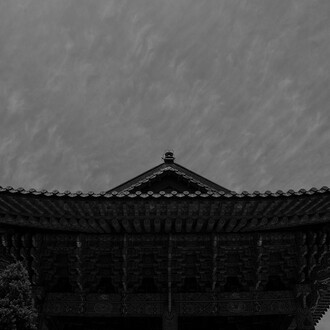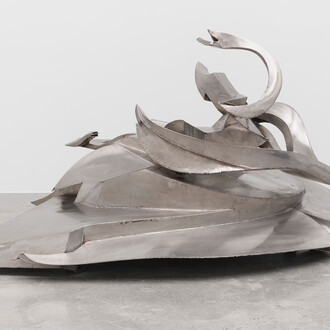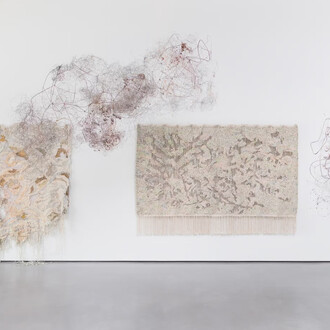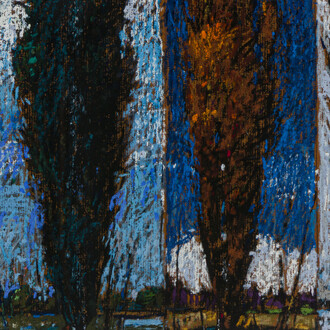Marian Goodman Gallery is pleased to present the first substantial solo exhibition in the United States by Edi Rama, artist and Prime Minister of Albania. It will contain a selection of colored pen on document paper drawings, hung on wallpaper made from them and many others, emulating the walls of Rama’s office in Tirana. The exhibition will also present a group of his new ceramic sculptures and a suite of the Inversion Drawings created with his long-term collaborator, the artist Anri Sala.
Rama, who was a practicing artist in Paris until being asked to return to Albania as Minister of Culture in 1998, explains that he initially started making his autonomous, stream-of-consciousness drawings directly onto government documents more from a sense of dislocation than a desire to create artworks: “I found myself drawing almost all my working time whilst interacting with people in my office or on the phone. And I came to appreciate that I wasn't drawing – my hand was.”
What Rama gradually realized – as Mayor of Tirana, then leader of the opposition, and since 2013 as a Prime Minister steering his country through a dramatic, often dangerous, period of creative transformation – was that his drawings were neither a diversionary activity nor an aesthetic indulgence, but becoming an increasingly elucidatory necessity: “I began to understand that my subconscious was being helped or fed by my hand to stay calm while my conscious had to focus on demanding topics and help me avoid mistakes of misjudgment through shallow concentration. Knowing this, later I deliberately took time to be alone and draw when difficult political decisions had to be made, when the calm my hands could teach my head was vital.” Later Rama not only started exhibiting his drawings as artworks, but took the decision to extend them, as printed wallpaper, across the walls of his ministerial office. These steps may have felt personally counterintuitive, “like leaving the monastery for playing the role of the creator on stage,” but made sense in the context of his transforming the wider building from what had been a bureaucratic, sequestered stronghold into what’s now entitled the Centre for Openness and Dialogue – including a contemporary art space, viewing rooms for public regeneration proposals, reading rooms and a lecture theatre.
He discovered an unexpected practical extension of the wallpaper: on entering his office, local visitors or international heads of state are immediately disarmed, even momentarily distracted by their surroundings, thus initially open to lateral ideas. Whilst excogitating that process, Rama has also looked forward to the next important step, that of bringing the wallpaper into the context of a public art space in this exhibition, which feels to him like “having a dream about my office, but where politics, with its characters and its struggles, has evaporated and what remains within the painted walls are these volumes, like archeological findings of what the life in that office once was… And my sense of being alive but at the same time part of the archeological era allows me to speak about, and others to ask about, both.”
Another extension of these works in this exhibition are a series of pieces made in collaboration with Anri Sala entitled Inversion Drawings. Most recently shown in Sala’s solo exhibition at the New Museum, they are constructed by Sala working on the verso of a selection of Rama’s drawings, revealing the ghosts of their reverse images, as if “creating space where there appears to be none.” Rama has known Sala since teaching him art in his home, when “a 10 year-old boy touched oil colours for the first time and made of his first ever canvas a still-life that looked like a Nabis masterpiece,” and collaboration – on works, publications, twoperson shows and when Sala curated the first exhibition of the contemporary art space Rama initiated in Tirana – has been an intuitive part of their friendship and practices since.
Displayed in this exhibition for the first time are ceramic sculptures that seem an embodiment of some of the palette and ruinscapes of an earlier Rama-Sala collaboration, the 2003 video work Dammi i Colori. Indeed Rama explains that the reason he’d so many colored pens within hand’s reach on his office desk in the first place, and hence such a broad palette for his drawings then sculptures, is his using them all over architects’ drawings to propose painting a kaleidoscope of colors that transformed the facades of Tirana public housing, the social project on which Dammi i Colori was based.
Rama’s new sculptures are ostensibly three-dimensional incarnations of his autonomous drawings, but the inherent contradictions in their premises make them more fascinating and enduring than that exercise implies. He’s grappling not only with the material constructs, of what happens to one’s subconscious faculties when you have the restraints of gravity and physical form to contend with, but also how to sustain your automated methodologies when you’ve removed yourself from the office and back into the atelier. Their ceramic surfaces can feel either arid or succulent, their structures and palettes in places cohesive, in others cacophonous, but they all have in common a curious sense of being hand-led mindscapes, improvised renderings of the very real shelters, caverns and grottos within Rama’s subconscious.
Edi Rama (b. 1964) lives and works in Tirana. A former professor of painting at the Academy of Fine Arts and author of several books, his works have been exhibited in numerous solo, two-person or group exhibitions including at the São Paulo Biennial (1994), Haus der Kunst, Munich (2004), the Centre Pompidou, Paris (2010), the Musée D’art contemporain de Montréal (2011), and the Tophane-i Amire Culture and Art Center, Istanbul (2015).
















